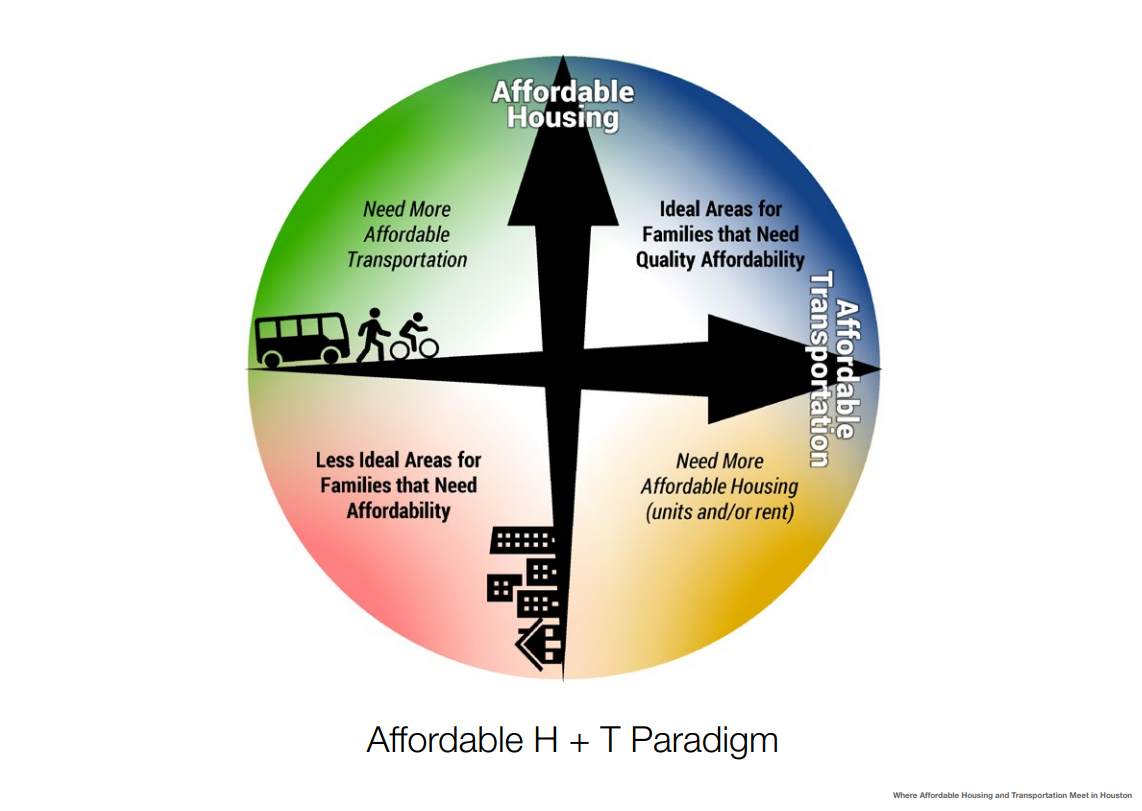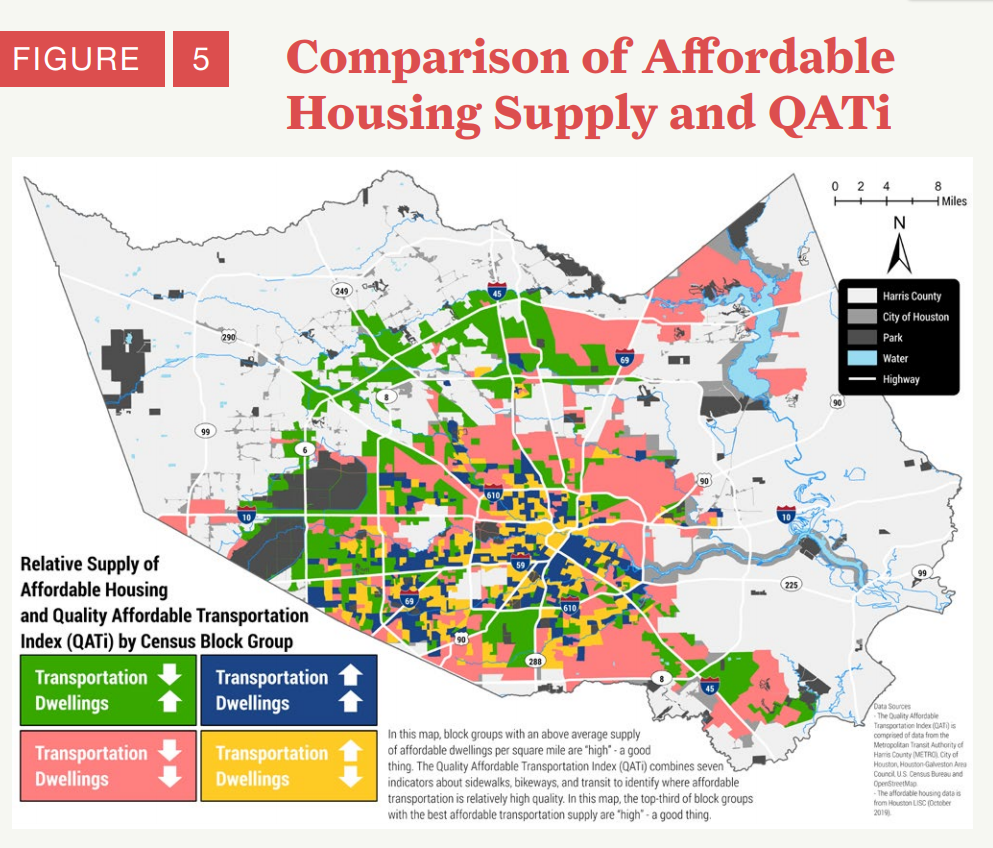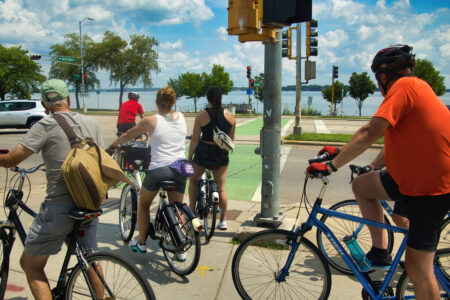
Share On Social!
Housing and transportation are two key ingredients for health equity.
In a good combination, people easily find affordable housing near schools, jobs, groceries, and healthcare.
In a bad combination, people struggle to find affordable housing near essential destinations and transportation options. They have to rely on expensive vehicle ownership or infrequent transit with unsafe streets and no sidewalks or bike lanes.
Which does your neighborhood have?
City leaders probably don’t know. So they aren’t able to invest in a meaningful mix of affordable housing and transportation. Residents can’t find a good combination, either.
LINK Houston is trying to change that.
The advocates’ report, Where Affordable Housing and Transportation Meet in Houston, helps city and community leaders identify housing and transportation affordability issues around town. It also helps people make informed decisions about where to live.
“Understanding the geographic intersection of housing and transportation helps to target investments, incentives and policies to preserve and develop affordable housing in locations that allow people to walk, bike and use transit, thus maximizing benefits to residents,” the report states.
Housing and Transportation Issues in Houston
Like many cities across the country, Houston (44.8% Latino) residents face skyrocketing rents and a decreasing supply of affordable housing to buy.
Hurricane Harvey made it worse.
Effectively addressing housing affordability means considering housing and transportation expenses together.
Why?
Auto ownership is expensive. Vehicles cost the average Houston resident $9,243 annually. More than 98% of residents are spending more than $7,300 annually.
To be considered affordable, transportation should account for less than 15% of annual income.
Of Houston’s 2.3 million residents, 71.6% spend more than 18% of their annual income on transportation. Two in five households spend more than 45% of their income on housing and transportation combined, meaning they are cost-burdened.
Improving affordable transportation options can help advance equity in housing, health, and wealth.

In a positive step, to ensure that long-term housing recovery is developed with transportation access in mind, the City of Houston included proximity to transit in its first round of Hurricane Harvey Community Development Block Grant—a portion of the $2 billion in federal funding for Hurricane Harvey recovery.
However, citywide, many decision-makers default to pursuing housing and transportation issues independently. And they didn’t know where housing and transportation issues were concentrated in the city. This made meaningful action impossible.
LINK Houston, a transportation advocacy group, wanted to make it easier for decisionmakers to systematically reinforce affordable housing and affordable transportation outcomes concurrently.
After all, LINK Houston had already looked at equity in transit in Houston.
Comparing the Location of Affordable Housing and Transportation in Houston
LINK Houston worked with Rice University’s Kinder Institute for Urban Research to co-develop a study to compare where affordable housing and where quality, affordable transportation exist.
The research team wanted to answer five questions:
- Where does affordable housing exist today?
- Where does quality, affordable transportation for people walking, biking and using transit exist today?
- What do we learn when overlaying the location of existing affordable housing and affordable transportation?
- How can practices in locating and designing affordable housing change to improve affordability by leveraging affordable transportation?
- How can we better counsel individuals and families to consider transportation in their housing decisions?
To answer those questions, they created the Quality Affordable Transportation Index (QATi). This combines seven indicators about sidewalks, bikeways, and transit to understand where quality, affordable transportation exists today.
Then they compared the QATi with the affordable housing supply, as well as with median gross rent.
They made some important findings:
- Only 44% of rental units in Houston are affordable to moderate-income households.
- Only 1 out of 3 of those affordable dwellings is near high-quality, affordable transportation.

The research team assigned and color-coded census block groups by one of four designations:
- Blue: Housed and Connected (affordable housing and transportation exist simultaneously)
- Yellow: Costly but Connected (shortage of affordable housing, but high-quality, affordable transportation)
- Green: Housed but Disconnected (adequate affordable housing, but less affordable transportation options)
- Red: Costly and Disconnected (shortages of affordable housing and affordable transportation)
Check out their interactive map.
Though this process, they identified priority areas for improving transportation and for improving affordable housing.
And they didn’t stop there.
Recommendations to Align Housing and Transportation Decision-making
Based on their study, LINK Houston made some recommendations to improve both housing and transportation quality and affordability.
They recommend to:
- Preserve and build affordable housing in areas with high-quality, affordable transportation.
- Increase opportunities to walk, bike and use transit near affordable housing.
- Map and monitor affordable housing and affordable transportation to demonstrate and direct the beneficial impacts of policies and investments in affordability for residents.
- Assess, compare and prioritize potential affordable housing sites to improve access to affordable transportation.
- Develop resources to help people understand how housing and transportation impact overall affordability.
To help people understand transportation needs and expenses, LINK Houston formed the Affordable Housing + Transportation Task Force to collaborate with community members, housing stakeholders and transportation stakeholders.
To assist governments and developers in better prioritizing affordable housing investments near quality, affordable transportation, they developed the Housing + Transportation Decision-maker Scorecard. The scorecard evaluates the quality of housing developments based on values and goals shared by Houstonians who walk, bike or use transit by choice or need.
To help housing and financial counselors assist their clients in considering transportation in their housing decision, they developed the Counselor Facilitation Guide: Considering Transportation in Decisions.
To help individuals understand their transportation needs when deciding where to live, they developed the Individual Workbook: Considering Transportation in Your Housing Decision.
“Finding housing in a location that also meets your transportation goals will improve your quality of life,” according to the report, “potentially reducing how much time and money you will spend going places you need to go in the future.”
What Can You Do to Stimulate a Good Mix of Housing and Transportation?
Local government and other affordable housing stakeholders must create policies, incentives and resources to prioritize affordable housing developments and improvements in areas where people can access frequent and low-cost transportation.
Transportation stakeholders—transit officials, regional planning offices, special districts and local government—must prioritize sidewalk, bikeway and transit improvements in areas where affordable housing exists now and will expand in the future.
You can help, too.
Share LINK Houston’s resources with leaders in your community. Push them to identify where affordable housing and affordable transportation meet—or not—to determine where to prioritize investment.
And download a Salud America! The Health Equity Report Card!
The Report Card auto-generates local data with interactive maps and gauges, which can help you visualize health inequities in housing, transit, and other health equity issues compared to the rest of your state and nation. You can email your Health Equity Report Card, share it on social media, and use it to make the case for community change to boost health equity, where everyone has a fair, just opportunity to live their healthiest.
“Affordable housing and transportation set the infrastructure for thriving neighborhoods,” said Sandra Rodriguez, President of the Gulfton Super Neighborhood Council #27.
By The Numbers
27
percent
of Latinos rely on public transit (compared to 14% of whites).



